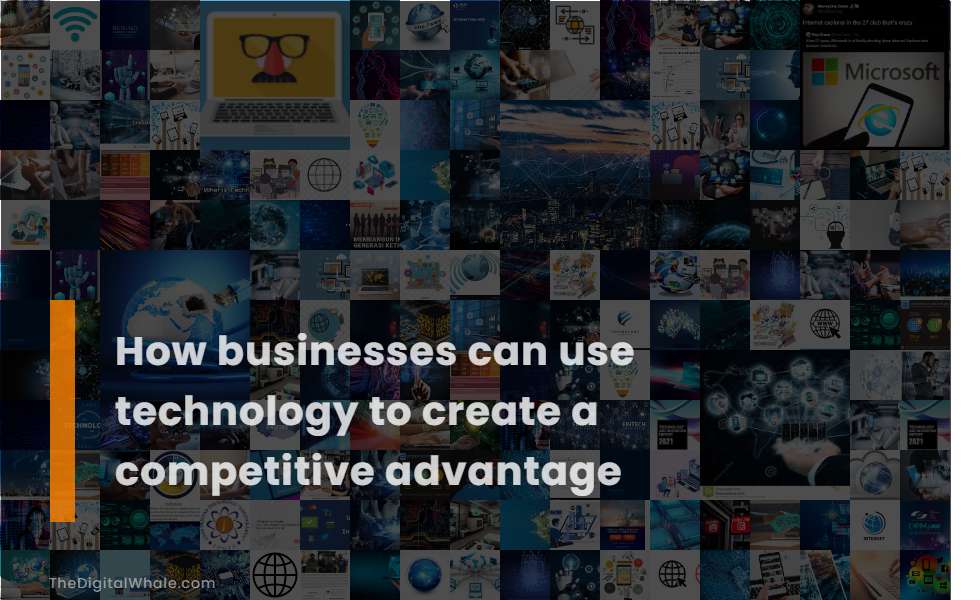How Businesses Can Use Technology To Create A Competitive Advantage
How can a business leveraging teleconference and collaboration tools improve performance? What are some dynamic technologies for small businesses to utilize to gain a competitive advantage? Let's find out more about How Businesses Can Use Technology To Create A Competitive Advantage.

Customer-centric approach through digital tools.
Businesses today can create a competitive advantage by adopting a customer-back business model (CBM), utilizing digital tools to sense and shape demand, optimize supply and fulfillment, and focus on aftersales service and customer engagement. This enables them to enhance customer experience and drive profitable growth. Through Customer Relationship Management (CRM) and other digital solutions, companies can analyze customer data to understand buying behavior, create tailored offerings, and segment customers based on their value, ultimately boosting profitability and competitiveness. More importantly, by leveraging insights and technology, as emphasized in McKinsey's insights on a Customer-Centric Strategy, brands can craft personalized digital experiences that meet specific customer needs. This approach not only improves communications and engagements but also allows businesses to differentiate themselves in a saturated market.
Reduce costs for increased profitability using digital tools.
Businesses can reduce costs and increase profitability by using digital tools such as automation, cloud hosting, and streamlining workflows, which eliminate manual and inefficient processes, optimize resource allocation, and enhance overall business efficiency. Implementing technologies like Robotic Process Automation (RPA), microservices, and virtualization can significantly reduce IT costs by automating tasks, improving resource allocation, and enhancing scalability, thereby increasing profitability. For more insights on optimizing resource allocation and enhancing overall business efficiency, consider exploring the strategies shared by Appinventiv.
Integration with third-party digital tools to enhance operations.
Integration with third-party digital tools can enhance operations by mitigating risk, saving money, and accelerating digital transformation projects. For example, tools like Salesforce CRM integrate with ERP vendors and Docusign to provide seamless contract workflows, increasing efficiency and ensuring regular software updates.
Provide better employee experiences with technology.
Businesses can create a competitive advantage by using technology to enhance employee experiences, such as providing modern workplace tools, minimizing downtime, and increasing employee engagement and satisfaction. Studies show a substantial increase in employee engagement and a significant likelihood of employees feeling valued when they have an agile and responsive PC experience. For more insights on improving employee experiences, you can visit the DXC Technology Blog which offers valuable perspectives on becoming an employer of choice.
Leveraging data and analysis for agility in decision-making.
Businesses can leverage comprehensive data analytics to gain deep insights into market trends, customer behavior, and internal processes, enabling agile decision-making, predictive actions, and rapid adaptations to market changes and customer demands. By using Big Data Analytics and Business Intelligence Tools, companies can uncover trends and patterns, drive innovation, optimize operations, and improve the customer experience, thereby making data-driven decisions that enhance their competitive edge.
Related:
Is a mobile phone essential for sales and marketing? What is the value of a mobile app used by employees to track their work progress? Let's find out more about Using Mobile Devices and Apps at Work - What'S Appropriate and What Isn'T?.
Utilize Large Language Models (LLMs) for efficiency and accuracy in various tasks.
Businesses can utilize Large Language Models (LLMs) to create a competitive advantage by leveraging their extensibility, flexibility, and high performance to automate routine tasks, enhance decision-making, and improve data analysis and insights. By doing so, they can increase efficiency, accuracy, and overall operational effectiveness. For more detailed information, explore how businesses can use LLMs to gain a competitive edge on TechTarget's page on Large Language Models.
Implement predictive technology and advanced analytics for real-time insights and process optimization.
Businesses today are leveraging technology to transform their operational efficiency. By utilizing advanced tools such as process mining, they gain real-time insights which help in optimizing processes by identifying bottlenecks and inefficiencies. This not only enables immediate corrective actions but also significantly enhances efficiency and adaptability. Moreover, the integration of AI for predictive analytics empowers businesses to make informed decisions by accurately predicting market trends and consumer behavior. This strategic use of AI aids in optimizing inventory levels and enhancing supply chain efficiency, consequently securing a competitive edge. For further understanding of these transformative technologies, visit the Real-Time Insights for Continuous Process Improvement page, offering deeper insights into how these advancements are reshaping business landscapes.
Strengthen data management and governance to secure and utilize data effectively.
Implementing a strong data management strategy and robust data governance enables businesses to streamline processes, improve decision-making, enhance data security, and leverage data for innovation and Competitive Advantage, ultimately driving business growth and efficiency.
Invest in cybersecurity to protect competitive advantage from sophisticated threats.
Investing in Cybersecurity allows businesses to gain a competitive advantage by efficiently meeting security standards, encouraging innovation, and building customer trust, thereby protecting their competitive edge against sophisticated threats. It is a decisive advantage as it builds trust, retains customers, and drives economic growth by integrating security features into product development and ensuring the stability of business operations. As highlighted in Digital Cxo, fostering a robust security framework is essential for businesses seeking to maintain relevance and competitiveness in an increasingly complex digital landscape.
Embrace digital transformation to streamline operations and enhance productivity.
Businesses can create a competitive advantage by embracing Digital Transformation to streamline operations and enhance productivity, utilizing technologies such as robotic process automation, AI, and data analytics to speed up processes, eliminate redundant tasks, and make data-driven decisions. Embracing digital change also helps businesses achieve operational efficiency by performing self-assessments, migrating to cloud services, embracing automation, and integrating systems, which results in reduced wasted time and labor, and improved overall efficiency. For more insights on how businesses can leverage these benefits, visit the TechTarget website.
Related:
What is the company's BYOD policy? What is the necessary steps for creating a Bring Your Own Device Policy in a small business? Let's find out more about Guidelines for Creating A Successful Byod (Bring Your Own Device) Policy.
